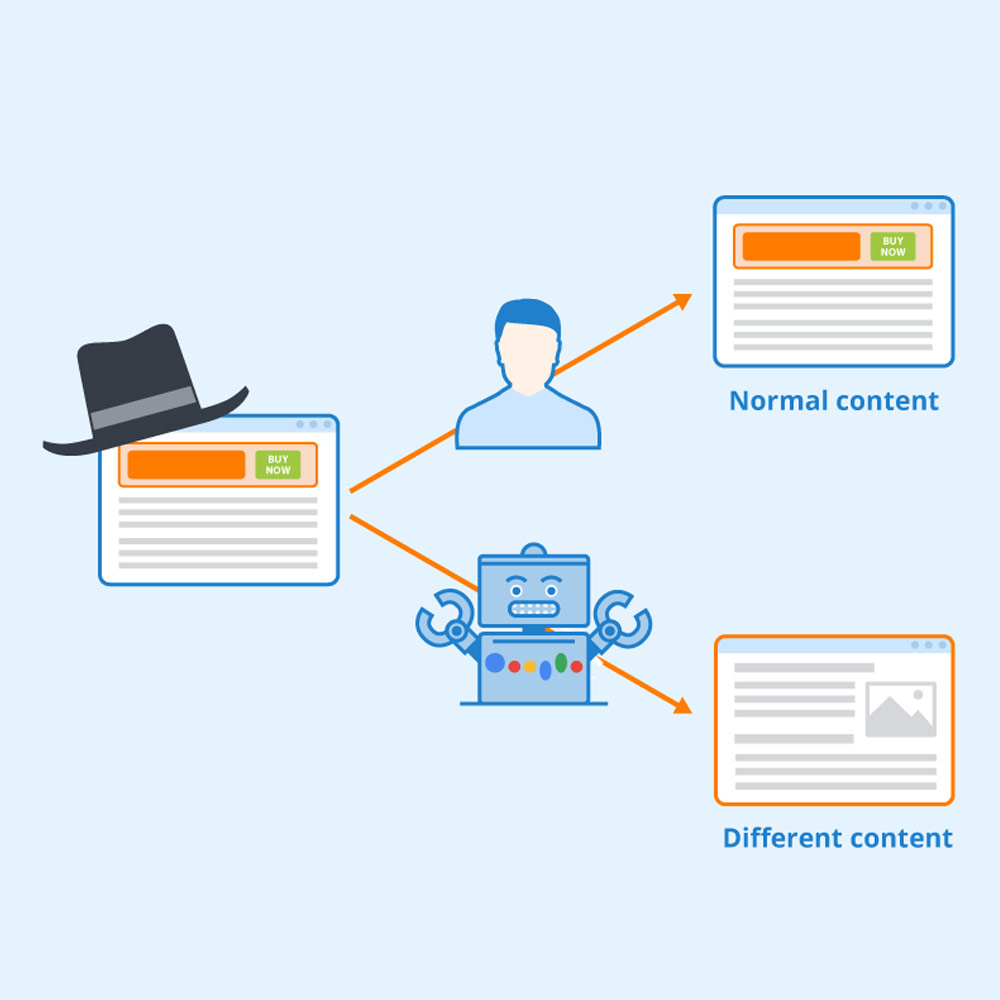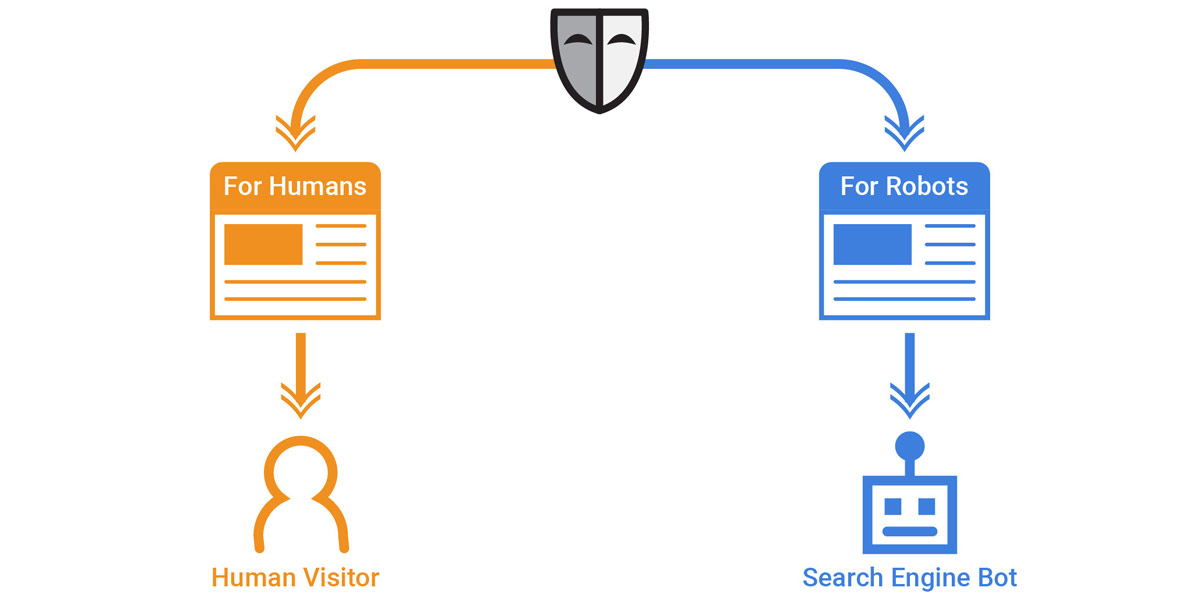What is Cloaking in SEO?

As a website owner or digital marketer, you may have heard of cloaking SEO, a controversial practice that involves presenting different content to search engines and users. Cloaking SEO has been around for many years, and while it can help improve search engine rankings, it can also harm your website’s reputation and lead to penalties. In this ultimate guide, we will explain everything you need to know about cloaking SEO, including its techniques, benefits, and risks.
Cloaking in SEO
Search engine optimization (SEO) is a complex and constantly evolving field that involves optimizing websites to rank higher in search engine results pages (SERPs). While many SEO techniques are legitimate and ethical, some are not and can harm your website’s reputation and ranking. Cloaking SEO is one of those controversial techniques that has been used by some webmasters to manipulate search engines.
In this guide, we will explain what cloaking SEO is, its techniques, benefits, and risks, and how to avoid penalties. We will also provide some FAQs at the end of the article to answer some of the most common questions about cloaking SEO.

Cloaking in SEO
What is Cloaking SEO?
Cloaking SEO is the practice of presenting different content or URLs to search engines and users. In other words, it is a deceptive technique that shows search engines one version of a web page while showing users another version. The purpose of cloaking SEO is to manipulate search engine rankings and attract more traffic to a website.
For example, a webmaster might use cloaking SEO to show search engines a page full of keywords and links while showing users a page with high-quality content and a user-friendly design. This technique is intended to fool search engines into thinking that the website is relevant and authoritative while providing users with a better experience.
Techniques of Cloaking SEO
There are several techniques of cloaking SEO that webmasters can use to deceive search engines. The following are some of the most common techniques:
IP Delivery Cloaking
IP delivery cloaking involves serving different content to users based on their IP addresses. For example, a website might show one version of a page to users from a specific country and another version to users from another country. This technique is often used to provide users with localized content or to comply with different laws and regulations.
User-Agent Cloaking
User-agent cloaking involves showing different versions of a page based on the user’s browser or device. For example, a website might show a desktop version of a page to users who access it from a computer and a mobile version to users who access it from a smartphone or tablet. This technique is intended to provide users with a better experience on different devices.
JavaScript Cloaking
JavaScript cloaking involves using JavaScript code to show different versions of a page to search engines and users. For example, a website might hide certain content or links behind JavaScript code that search engines can crawl, but users cannot see. This technique is often used to hide spammy or low-quality content from users while showing it to search engines to improve rankings.
HTTP Referrer Cloaking
HTTP referrer cloaking involves showing different versions of a page based on the referrer URL. For example, a website might show a different version of a page to users who come from a search engine results page (SERP) than to users who come from a social media website. This technique is often used to improve the relevance and quality of the landing page for specific search queries.

Techniques of Cloaking SEO
Benefits of Cloaking SEO
While cloaking SEO is considered a black hat SEO technique and is discouraged by search engines, it can provide some benefits to webmasters who use it. The following are some of the benefits of cloaking SEO:
Higher Rankings
Cloaking SEO can help webmasters achieve higher rankings for specific keywords by presenting different content to search engines. By showing search engines content that is optimized for specific keywords, webmasters can improve their chances of ranking higher in SERPs.
Targeted Traffic
Cloaking SEO can also help webmasters attract more targeted traffic to their websites. By presenting different content to different users based on their location, browser, or referrer, webmasters can provide users with more relevant and personalized content, which can lead to higher engagement and conversion rates.
Competitive Advantage
Cloaking SEO can provide webmasters with a competitive advantage over their competitors who do not use this technique. By presenting different content to search engines, webmasters can rank higher for specific keywords, attract more traffic, and generate more revenue.

Benefits of Cloaking SEO
Risks of Cloaking SEO
While cloaking SEO can provide some benefits to webmasters, it also poses several risks that can harm their website’s reputation and ranking. The following are some of the risks of cloaking SEO:
Penalties
Cloaking SEO is a violation of Google’s guidelines and can lead to penalties, including a lower ranking or even complete removal of the website from the search index. Penalties can also harm a website’s reputation and credibility, which can lead to lower traffic and revenue.
User Experience
Cloaking SEO can harm the user experience by presenting different content to search engines and users. Users may feel deceived or misled if they see different content than what they expected or if they cannot access certain content or links that are hidden behind JavaScript code.
Ethical Concerns
Cloaking SEO is considered a black hat SEO technique and is discouraged by search engines. Using this technique can harm a website’s reputation and credibility, which can have long-term effects on the website’s success.

Risks of Cloaking SEO
How to Avoid Cloaking SEO Penalties
To avoid cloaking SEO penalties, webmasters should follow Google’s guidelines and use a white hat SEO approach. The following are some tips on how to avoid cloaking SEO penalties:
Follow Google’s Guidelines
Webmasters should follow Google’s guidelines and avoid any practices that deceive search engines or manipulate rankings. They should focus on providing high-quality and relevant content to users and avoid any tactics that harm the user experience.
Use a White Hat SEO Approach
Webmasters should use a white hat SEO approach and focus on ethical and legitimate SEO techniques. They should avoid any black hat SEO techniques, including cloaking SEO, that can harm their website’s reputation and ranking.
Monitor Your Website’s Performance
Webmasters should monitor their website’s performance regularly and keep an eye on any changes in rankings or traffic. They should also use tools like Google Search Console to identify any issues or penalties and take appropriate actions to fix them.

How to Avoid Cloaking SEO Penalties
Conclusion
Cloaking SEO is a controversial technique that involves presenting different content to search engines and users. While it can provide some benefits to webmasters, it also poses several risks that can harm their website’s reputation and ranking. Webmasters should follow Google’s guidelines and use a white hat SEO approach to avoid any penalties or negative consequences.
While it may be tempting to use cloaking SEO to achieve higher rankings or attract more targeted traffic, it is important to consider the long-term consequences of this technique. Ultimately, the best way to achieve sustainable success in SEO is to focus on providing high-quality and relevant content to users and following ethical and legitimate SEO practices.
FAQ
What is cloaking in SEO?
Cloaking is a black hat SEO technique that involves presenting different content to search engines and users to manipulate rankings and attract more traffic.
Is cloaking good or bad for SEO?
Cloaking is considered a bad practice in SEO because it can deceive search engines and users and harm the user experience. It is also a violation of Google’s guidelines and can lead to penalties or a lower ranking.
What are some examples of cloaking in SEO?
Some examples of cloaking in SEO include using hidden text or links, presenting different content to search engines and users, and redirecting users to a different URL than the one they clicked on.
How does cloaking affect search engine rankings?
Cloaking can hurt search engine rankings because it can be detected and penalized by search engines. It can also harm the user experience and lead to a lower ranking.
What are the different types of cloaking techniques?
There are several different types of cloaking techniques, including IP cloaking, user-agent cloaking, and JavaScript cloaking.
How do search engines detect cloaking?
Search engines detect cloaking by comparing the content presented to users with the content presented to search engines. They also use algorithms and crawlers to detect cloaking techniques.
Why do websites use cloaking in SEO?
Websites use cloaking in SEO to manipulate rankings and attract more traffic. Some may also use it to hide content from users or to present different content to different user groups.
What are the risks of using cloaking in SEO?
The risks of using cloaking in SEO include penalties, a lower ranking, harm to the user experience, and ethical concerns. It can also harm the website’s reputation and credibility.
How can you avoid cloaking in SEO?
You can avoid cloaking in SEO by following Google’s guidelines, using a white hat SEO approach, and monitoring your website’s performance regularly. You should also avoid using any black hat techniques that could harm your website’s reputation and ranking.
What are some alternative SEO strategies to cloaking?
Some alternative SEO strategies to cloaking include creating high-quality and relevant content, using keywords strategically, optimizing website speed and performance, and building high-quality backlinks. These strategies can help improve your website’s ranking and attract more targeted traffic without resorting to unethical practices like cloaking.

